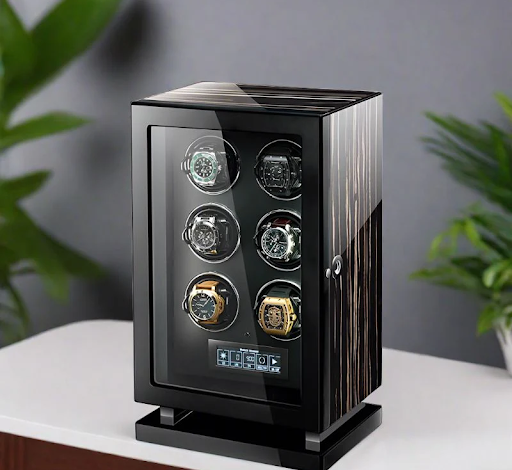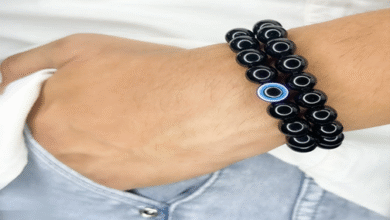Automatic Watch Winding Box: A Complete Guide

Introduction
An automatic watch winding box is an essential accessory for watch enthusiasts who own self-winding mechanical watches. These sophisticated devices ensure that your timepiece remains powered and ready for use, eliminating the need for manual winding and preventing wear from frequent adjustments.
In this article, we will explore the purpose, benefits, and key considerations when choosing an automatic watch winder. We will also address common questions and provide maintenance tips to maximize the lifespan of both your watch and the winder itself.
What Is an Automatic Watch Winding Box?
An automatic watch winding box, often called a watch winder, is a device designed to keep self-winding mechanical watches ticking when they are not being worn. These watches rely on the movement of the wearer’s wrist to power the mechanism inside. When left stationary for too long, they stop running and require manual winding.
The winding box uses a motorized rotating mechanism that mimics wrist movement, keeping the watch wound and functional even when it’s not in use.
How Does an Automatic Watch Winder Work?
A watch winder operates using a rotating mechanism powered by an electric motor. The key components include:
- Watch Holder – Securely holds the watch in place.
- Motor – Powers the rotating motion.
- Control Panel – Allows the user to adjust settings such as rotation direction and speed.
- Power Source – Can be battery-operated or plugged into an electrical outlet.
Rotation Settings
Watch winders typically offer multiple rotation settings:
| Setting | Description |
| Clockwise (CW) | Rotates in rightward direction. |
| Counterclockwise (CCW) | Rotates in leftward direction. |
| Bidirectional | Alternates between CW and CCW to suit different watch mechanisms. |
The ability to select the rotation direction is crucial, as different automatic watches require specific winding patterns.
Benefits of Using an Automatic Watch Winding Box
Investing in a watch winder provides several advantages:
Keeps Your Watch Ready to Wear
With a watch winder, your automatic watch remains powered, ensuring accurate timekeeping. You don’t need to reset the time, date, or other complications before wearing it.
Prevents Lubrication from Drying Out
Mechanical watches contain delicate gears and lubricants. When a watch remains idle for too long, the lubricants can thicken or dry out, affecting performance. A winder keeps the movement active, reducing this risk.
Minimizes Manual Winding and Adjustments
Frequent manual winding or setting can put unnecessary strain on the crown and movement. A winder helps extend the watch’s longevity by reducing the need for constant handling.
Enhances Watch Organization and Protection
A watch-winding box serves as a safe storage unit, protecting your timepiece from dust, moisture, and accidental damage while keeping it neatly displayed.
Choosing the Right Automatic Watch Winder
When selecting a watch winder, consider the following factors:
1. Rotation Compatibility
Ensure the winder supports the correct rotation direction for your watch. Some watches require clockwise winding, others counterclockwise, and many need bidirectional winding.
2. Turn Per Day (TPD) Settings
TPD refers to the number of rotations needed to keep a watch wound. Watches typically require 600 to 1200 TPD, so choose a winder with adjustable settings to match your watch’s specifications.
3. Power Source
Watch winders can be AC-powered (plug-in) or battery-operated. If you need portability, a battery-powered model is more convenient, while an AC-powered option ensures continuous operation.
4. Noise Level
Some watches can be noisy due to motor vibrations. If you plan to place it in a bedroom or office, opt for a model with a silent or low-noise motor.
5. Storage Capacity
Watch winders come in various sizes:
- Single Watch Winders—Ideal for individuals with one automatic watch.
- Multiple Watch Winders—Suitable for collectors with several watches.
6. Build Quality and Design
A well-built winder should feature durable materials, such as wood, leather, or carbon fiber, with a soft interior lining to prevent scratches on the watch.
Maintenance Tips for Your Watch Winding Box
To ensure the longevity of both your watch and the winder, follow these maintenance tips:
- Clean the interior and exterior regularly using a microfiber cloth to remove dust.
- Avoid placing the winder in direct sunlight or humid environments to prevent damage.
- Check the power supply and motor function periodically to ensure smooth operation.
- Use the correct TPD and rotation settings to match your watch’s requirements.
Conclusion
An automatic watch winding box is a valuable accessory for watch collectors and enthusiasts who want to keep their timepieces in optimal condition. By choosing the right winder based on rotation settings, TPD, power source, and build quality, you can enhance the performance and longevity of your automatic watch.
Whether you own a single luxury watch or an extensive collection, a well-selected watch winder provides both convenience and protection, ensuring your watches remain ready to wear at all times.
FAQs
1. Do All Automatic Watches Need a Watch Winder?
No, but they are beneficial for watches with complex features such as perpetual calendars, moon phases, or multi-time zones, which require time-consuming adjustments if they stop running.
2. Can a Watch Winder Overwind a Watch?
No, modern automatic watches have a slip-clutch mechanism that prevents overwinding. However, using a winder with the wrong TPD setting may cause unnecessary wear.
3. Should I Keep My Watch in a Winder All the Time?
It is safe to keep a watch in a winder, but it’s a good idea to give it some time off occasionally to mimic natural wrist movement patterns.
4. Can a Watch Winder Damage a Watch?
Only if the rotation settings or TPD exceed the manufacturer’s recommendations. Using a properly calibrated winder will not harm the watch.



